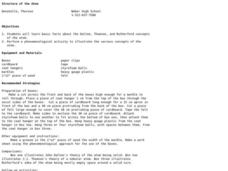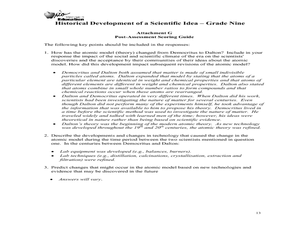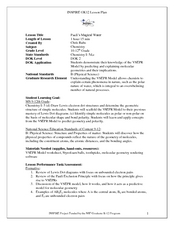Santa Monica College
Lewis Structures and Molecular Shapes
Learners practice drawing Lewis dot structures, build molecules with model kits, and predict molecular shapes using VSEPR theory. The combination of written work and hands-on reinforcement benefits young scientists.
Curated OER
VSEPR Theory: Valence Shell Electron Pair Repulsion Theory
In this atoms worksheet, students complete a graphic organizer by filling in the number of atoms, number of electron pairs, number of long pairs, bond angle, and molecular shape.
Curated OER
Elements of Chemistry: Atoms: The Building Blocks of Matter
Students explore scientific theories and the works of scientists. In this chemistry lesson students develop a timeline that shows how scientists work was built on the ones before them.
Curated OER
Structure of the Atom
Students observe 3 models that show Dalton, Thomson and Rutherford's theories of the structure of the atom. In this structure of the atom lesson plan, students observe each model and write a summary of each theory of the atom.
Curated OER
Atomic Structure - Part A
Young scholars describe the structure of atoms, including the particles that make them up. They recognize that key scientists and experiments have contributed to the changes
in the Atomic Theory.
Curated OER
Mystery : Structure of the Atom-A Case for Indirect Evidence
Students investigate the structure of the atom through hands on activities. In this atomic structure lesson, students perform 4 activities showing indirect evidence of the structure of the atom and the parts of the atom. They also list...
Curated OER
Atomic Structure and Quantum Theory
Pupils are introduced to the structure of an atom and Dalton's atomic theory through a short video and mini-lecture. They also take a look at the weight of mass and become familiar with the idea of quantum theory
Curated OER
Atoms: The Building Block of Matter
Learners examine how scientific theories are developed. In this matter lesson plan, students explore the basic idea of quantum theory. They create a timeline of scientists, their contributions, and discoveries.
Curated OER
Atomic Structure
In this atom worksheet, learners define the atomic theory, compare an atom and a molecule, determine atomic number and number of protons for elements, and draw Bohr models for given elements. This worksheet has 4 graphic organizer, 8...
Curated OER
Physicists or Philosophers?
Trace the sequential process of the developing theories of atomic structure in the early 20th century, show, in historical development, how scientists "know" things, how experiments are set up and how interpretations are drawn from them,...
Curated OER
The Nature of Matter
Students compare and contrast how the theory of atomic structure has changed over time. They explore how different people have contributed to our knowledge of the atom and its structure. Students identify how matter is made of discrete...
Virginia Department of Education
Molecular Model Building
During this hands-on activity, young chemists build molecular models based on the Lewis dot structure before studying valence shell electron pair repulsion theory.
Curated OER
Atoms, Kinetic Theory, Solids and Fluids
Students identify and describe the building blocks that make up an atom. They also compare the ages of atoms to the ages of the materials they compose,as well as, give examples that illustrate the small size of atoms.
Curated OER
How Can You Study Things You Can’t See Like: Atoms?
Students simulate how scientists studied things they can't see like atoms. In this chemistry lesson, students predict what is inside the numbered obsertainers. They design a way to investigate what's inside without opening it.
Curated OER
Discovering the Structure of the Atom
Students investigate atomic and nuclear structure of matter by researching historical atomic theories. Students examine Rutherford's studies and discover that many scientific conclusions change over time as new data is collected.
Curated OER
Historical Development of a Scientific Idea
Ninth graders examine how scientist's contribute to atomic theory. In this development of a scientific idea instructional activity students work in groups and research the development of the atomic model.
Curated OER
Matter
Fifth graders investigate the structure of matter. They examine pictures of atoms and molecules and discuss their relationships, and construct a model of a molecule using toothpicks and gumdrops.
Curated OER
Molecular Architecture
Students cuminate their study of molecular structure and bonding with this activity.
Curated OER
Applied Science - Physics Pre-Lab
Students describe the science of physics. In this Physics lesson plan, students observe examples of physics within their classroom. Students create a definition for physics.
Curated OER
Gumdrop Crystal Models
A great way to learn about molecular structures is to make a model. Gumdrops and toothpicks are used to construct crystal models. The models are based on theories of crystal shapes that occur because of positive and or negatively charged...
Virginia Department of Education
Elements and Electron Configuration
It's electronic! Pupils uncover elements and their electron configurations as they explore mass, groupings, correct charges, and sliding theory. Young scientists learn creative ways to remember various elements and correctly...
Curated OER
Molecular Models Laboratory
Students use models to visualize molecular structures. Students read about Lewis dot structures, hybridization, and formal charge. Then students build and draw the molecules and ions given. Students complete 11 pre-lab questions and 4...
Curated OER
Modern Physics, Old QT
In this physics worksheet, students develop an understanding of the atomic model and how atoms relate to one another through answering the seven questions.
Curated OER
Pauli's Magical Water
Students predict the shape of molecules using VSEPR theory. In this chemistry lesson, students differentiate a polar and nonpolar molecule. They discuss why water's polarity is very important.























